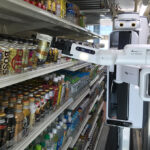
(Source – Shutterstock)
Are AI and robots making workers lazier?
When AI started to be integrated into machines, many industries were hoping that it will solve the biggest problem they face today – the shortage of workers. For most industries that deal with manufacturing, packaging, logistics, and such, employing a sufficient and efficient workforce continues to be a challenge.
The challenges soon became the main disruptive factor when the COVID-19 pandemic saw many factories and plants having to stop their activities due to lockdowns. While the situation has since improved, the reality is, that the reliance on the human workforce has been a concern.
To deal with these, the industry began adopting more automated machinery. These machines could work round the clock, which enhanced productivity. With the integration of AI, some of these machines could operate fully without any human intervention at all.
For example, some shipping and logistic companies have already implemented fully autonomous technologies that are able to complete most tasks. In logistics, autonomous trucks are solving driver shortage problems while autonomous robots are completing stocking and stacking activities in warehouses.
With the advancements of deep learning in AI, robotics is now seemingly becoming the next phase. Several tech companies are designing humanoid bots that can complete more tasks and enhance the capabilities of the workforce. The Tesla Bot and Xiaomi’s CyberOne are just some of the examples of robots that can be more helpful in completing manual and repetitive tasks.
However, with technology enabling robots to be embedded with AI and do more tasks, there is another question that some are pondering. If robots are going to be doing all the work, what is everyone else going to do?
Recently, Google announced that its combing its robots with the knowledge and conversation skills of chatbots to help its employees fetch soda and chips from breakrooms with ease. To be precise, employees would say, “Google, get me a Coke” and the robot would go and get it.
According to a report by Reuters, the robots interpret naturally spoken commands, weigh possible actions against their capabilities, and plan smaller steps to achieve the ask. Simply put, the robot can perhaps get someone a sandwich but will not be able to make one from scratch yet.
While this sounds fascinating, the main concern about this is whether will it make employers lazier. Asking a machine to get a can of Coke is probably the simplest task for most people. Getting a robot to do it would mean not getting up to walk around and get a beverage. But for what reason? Are employers in Google so busy that they cant even get a can of Coke? Or is it just a sign of what the future could be like?
When it comes to autonomous cars, for example, there are now models that are fully automated and do not have steering wheels. Currently, when driving, a driver would need to pay attention to everything. Now, the driver and passengers can just relax and let the AI do its job.
In the future, Google says the robots can do more tasks, despite concerns that these machines could be used for other purposes, like surveillance and such. Again, while the technology allows it, should it be adapted for such reasons?
Perhaps over time, more use cases can be developed. For now, though, getting a robot to get a can of Coke is perhaps like having a maid do everything. The technology should be used to enhance work and automate tasks.
READ MORE
- The criticality of endpoint management in cybersecurity and operations
- Ethical AI: The renewed importance of safeguarding data and customer privacy in Generative AI applications
- How Japan balances AI-driven opportunities with cybersecurity needs
- Deploying SASE: Benchmarking your approach
- Insurance everywhere all at once: the digital transformation of the APAC insurance industry


